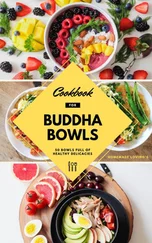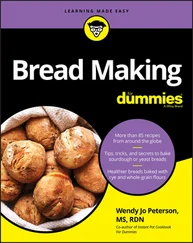Get kids involved in the meal planning and preparation for the week. Even if a picky eater won’t eat the food, it’s okay for them to help prep it. Kids are far more capable than we realize. Have them help with making yogurt parfaits or overnight oats. Let them build their own salad in a jar — even if it’s nothing but bacon and ranch! The more they’re exposed to new foods, even by touching the foods, the better!
Chapter 2
Knowing Which Supplies You Need
IN THIS CHAPTER
 Stocking your kitchen with the best tools for meal prep
Stocking your kitchen with the best tools for meal prep
 Identifying some tools to add to your wish list
Identifying some tools to add to your wish list
Having the right tool for the job can really help save time and energy when meal prepping. You may already have on hand some tools; others you may need to buy. Assess your kitchen and see if you have the storage space for some fancier items. A cluttered kitchen will leave you less inspired to cook, so skip any unnecessary tools and stick to the basics.
Must-Haves: Tools You Need for Meal Prep
When you’re committed to meal prep, certain tools are just a requirement. The following sections cover those tools you need to meal-prep with ease.
A chef’s knife is an all-purpose knife, perfect for slicing and dicing vegetables, chopping meats, or chopping nuts. A 6- or 8-inch version is a great tool to have on hand, especially as your knife skills improve (see the nearby sidebar). For most home kitchens, a mid-priced knife is good enough. Many great brands are out there, from Wüsthof ( www.wusthof.com ) to Henckels ( www.zwilling.com/us/henckels-international/cutlery ).
SHARPENING YOUR KNIFE SKILLS
Learning how to hold and work a knife can make you much more efficient in the kitchen. In culinary school, knife skills are always taught within the first week and emphasized throughout all courses. The following photo shows how to hold a knife. In order to have a stable grip on a chef knife, grip the handle and inch your hand up toward the blade. Your thumb should be on the metal part of the blade, and your index finger should be gripped over the top of the knife. If you just hold the handle, the knife isn’t as stable and can slip.
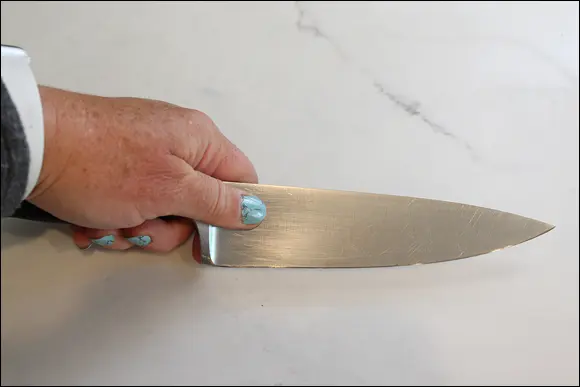
Photograph by Wendy Jo Peterson and Geri Goodale
Learning how to cut foods evenly helps with aesthetics but also with improved cooking times. Here are some popular cuts referred to in cookbooks, including this one (see the following photograph for what the cuts look like):
Julienne (top left): Also referred to as matchsticks, these are narrow strips that are the same length and width. A thicker julienne cut could be referred to as a bâtonnet.
Chiffonade (top right): This is when you roll up greens, like basil or kale or spinach, and do thin cuts to give a shredded appearance.
Brunoise (bottom left): This is a tiny dice. Typically, you start with the julienne cut and then do a small dice from the narrow strips. These create uniformity in salads or soups.
Dice (bottom right): Small, medium, or large diced items are squared pieces that are of equal size.
Rounds (bottom middle): From carrots to cucumbers, slicing rounds is keeping the round shape, but slicing of equal thickness.
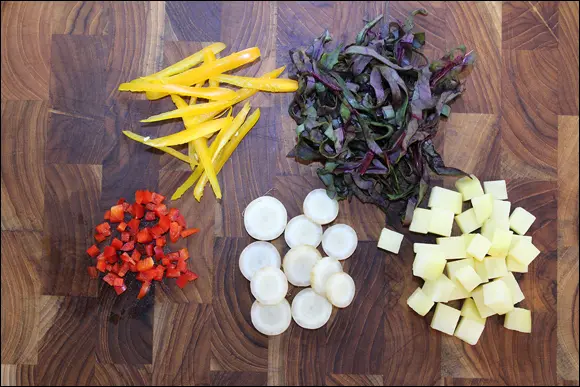
Photograph by Wendy Jo Peterson and Geri Goodale
Be sure to keep your knives sharp. A sharp knife is less likely to cause an accident than a dull blade. A dull blade can slip with pressure, possibly causing injury.
 A knife that has the metal blade extend throughout the handle is more stable and less likely to break over time. Be sure to hand-wash a good knife and dry it immediately to extend the life of your knife.
A knife that has the metal blade extend throughout the handle is more stable and less likely to break over time. Be sure to hand-wash a good knife and dry it immediately to extend the life of your knife.
Wooden cutting boards are my absolute favorite for cutting all foods. Using a good mineral oil on your clean cutting boards will help extend their life and prevent bacteria from inching its way into the grooves of the board. Wooden cutting boards are also friendly on your knives, unlike stone varieties.
If food contamination is an issue or concern, pick up colored plastic cutting boards and label them for the use (for example, green for vegetables and fruits, red for meats, yellow for poultry, blue for fish, and white for all other foods). A bonus to plastic cutting boards is that many are dishwasher safe!
Measuring spoons and cups
Pick up a set of volumetric measuring spoons and cups. The recipes in this book use the standard American tool for volumetric measuring.
Having one good, heavy-duty aluminum sheet pan is especially useful if you enjoy sheet-pan meals! Nordic Ware ( www.nordicware.com ) is my top pick for sheet pans.
Ideally, have a 9-x-13-inch casserole dish and either a 9-x-9-inch or an 8-x-8-inch casserole dish. Baking dishes are essential for meal prep and executing a fast meal.
 Metal casserole dishes conduct heat better than tempered glass or stoneware, so depending on the pan you use, you may need to alter the bake time.
Metal casserole dishes conduct heat better than tempered glass or stoneware, so depending on the pan you use, you may need to alter the bake time.
Muffin pans aren’t just for baking muffins. They’re great for baking mini meat loaves, frittatas, or portioned-out items. If you’re short on storage space, consider picking up silicone individual muffin holders — they’re sturdy and they can be baked on a sheet pan instead.
When it comes to easy clean up, parchment paper is a must-have kitchen buy. It’s safe at high oven temperatures, and it helps keep foods from sticking to sheet pans while baking. Just make sure you don’t mistake wax paper for parchment paper — they aren’t the same thing!
Blame it on my culinary training, but I’m a firm believer that every kitchen needs a digital thermometer, particularly the instant-read variety. Whether you’re checking to see if your meat loaf is fully cooked or whether your steak is cooked to perfection, having a thermometer on hand can save you from cutting into food to check for doneness and losing precious juices and drying out your food. Pick up a simple one by OXO ( www.oxo.com ) or a more expensive one by ThermoWorks ( www.thermoworks.com ); they range in price from $20 to $100.
When it comes to storage containers, you need two types:
Silicone: Reusable silicone storage containers are dishwasher, microwave, and often oven safe. They’re also free of the harmful chemicals found in plastic products that can leach into your foods. Some of my favorite products are Souper Cubes ( www.soupercubes.com ) for portioning out pasta sauce, soups, or stews and freezing to enjoy later. (re)zip ( https://rezip.com ) storage bags are leakproof and stand up for easy storage organization in the refrigerator. Net Zero Company ( www.netzerocompany.com ) makes stretchable silicone storage lids, which helps minimize the use of plastic wrap.
Читать дальше
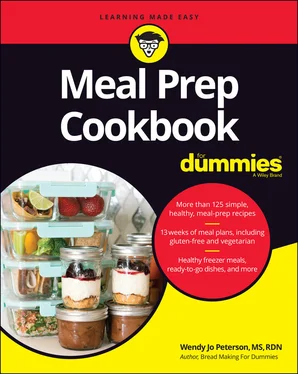
 Stocking your kitchen with the best tools for meal prep
Stocking your kitchen with the best tools for meal prep

 A knife that has the metal blade extend throughout the handle is more stable and less likely to break over time. Be sure to hand-wash a good knife and dry it immediately to extend the life of your knife.
A knife that has the metal blade extend throughout the handle is more stable and less likely to break over time. Be sure to hand-wash a good knife and dry it immediately to extend the life of your knife.
